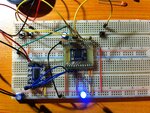kaning
Junior Member level 3
Hi all,
Im using a pam8403 2x3w module audio amplifier and BLK-MD-SPK-B bluetooth module receiver (datasheet here). for this thread sake i've made a simple schematic to show you the problem im having. last time i built this schematic (last summer) this noise was not ocurring.
I've been reading a lot and search about possible solutions, like proper grounding, wich i dont think its the case. anyway its my first audio project and im quite newbie in handling audio signals. i've tried several other things but with no success, here is a demonstration.
how it looks on the breadboard.

View attachment PKB_peripheral_circuit_design_2 (1).jpg
the only diference from theese pictures is that im using a 100uf capacitors on both battery and 1.8v output. also tried to to add extra cap more near the bluetooth pins but nothing changed.
important note: this problem is somehow connected to bluetooth module because without it you can only hear small "ch" noise, when bluetooth module connected to phone and amplifier you hear whats in the video. many thanks in advance.
Im using a pam8403 2x3w module audio amplifier and BLK-MD-SPK-B bluetooth module receiver (datasheet here). for this thread sake i've made a simple schematic to show you the problem im having. last time i built this schematic (last summer) this noise was not ocurring.
I've been reading a lot and search about possible solutions, like proper grounding, wich i dont think its the case. anyway its my first audio project and im quite newbie in handling audio signals. i've tried several other things but with no success, here is a demonstration.
how it looks on the breadboard.

View attachment PKB_peripheral_circuit_design_2 (1).jpg
the only diference from theese pictures is that im using a 100uf capacitors on both battery and 1.8v output. also tried to to add extra cap more near the bluetooth pins but nothing changed.
important note: this problem is somehow connected to bluetooth module because without it you can only hear small "ch" noise, when bluetooth module connected to phone and amplifier you hear whats in the video. many thanks in advance.